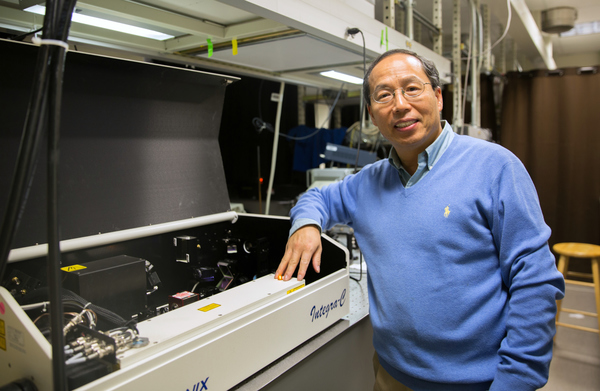A gold bullet for cancer?
A chemist with expertise in nanotechnology and optical sensors is pursuing a novel approach to cancer therapy, with help from an unexpected source
When Tony Kisiel’s wife had breast cancer, he did what a lot of cancer patients and their family members do—he turned to the internet. “I always thought I was smart enough to help her, and I had a whole stack of technologies I had gleaned off the internet,” he said.

In 2010, he read about research by Jin Zhang, professor of chemistry and biochemistry at UC Santa Cruz, that he thought sounded especially promising. Zhang, working with researchers at M.D. Anderson Cancer Center, had developed a way to selectively kill cancer cells using custom-designed gold nanoparticles. But when Kisiel reached him by phone, Zhang explained that the technique was still a long way from clinical use.
“He told me it was not FDA approved and they were still working on it. So we couldn’t help her,” Kisiel said. His wife passed away six months later, but Kisiel kept thinking about what Zhang’s therapy might be able to do for other patients. After his wife’s funeral, Kisiel traveled to Santa Cruz from his home in Michigan, handed Zhang a check, and spent six hours with him learning about the research and discussing how he might help.
Kisiel has a background in engineering, and his company, Smart Technologies, specializes in bringing intellectual property to the marketplace. As a result of Kisiel’s connections, Zhang’s cancer research is now being supported by Delta Dental, which is interested in its potential as a therapy for hard-to-treat oral cancers.
“With my background in business and engineering, I thought we could use our resources to help move this work forward,” Kisiel said. “I think this technology is ready, and our objective now is to get it into clinical trials.”

For Zhang, whose expertise is in nanotechnology and optics, cancer research is an unexpected focus. It came about when he heard a talk at a scientific meeting about “photothermal ablation,” using light and heat to selectively kill cancer cells, and realized that his lab had already developed the nanotechnology needed to make it work.
Zhang’s lab had perfected the synthesis of hollow gold nanospheres with consistent size and optical properties. For cancer therapy, short peptides attached to the nanospheres enable them to bind selectively to cancer cells. Irradiating the tumor with near-infrared light from a laser then heats the gold nanospheres, killing the cancer cells to which they are bound. Side effects are minimized because it involves no drugs or chemotherapy and no harmful radiation.
“This approach has a lot of promise,” Zhang said. “It just takes time and effort to optimize the technology and get it into clinical use.”
The road from the research lab to the clinic is long and fraught with pitfalls, and many promising ideas for new therapies drop by the wayside. Sometimes, however, chance encounters along the way provide the connections needed to move things along. In the case of Zhang’s research, he has found a determined supporter in Tony Kisiel.
“I just decided I was going to do something about this, because we can affect thousands of people’s lives,” Kisiel said.
